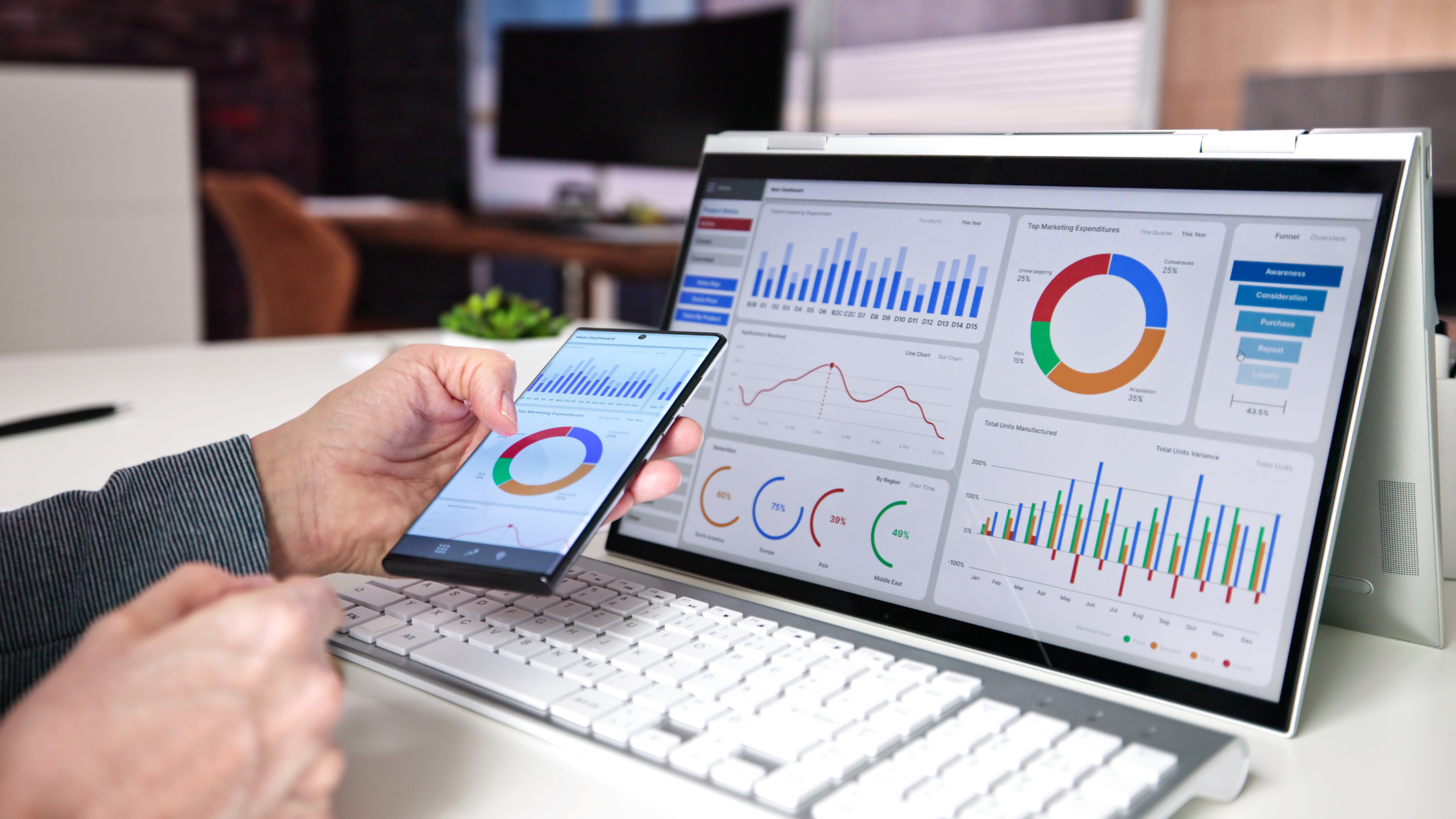Data is the driving force behind operational efficiency, compliance, and cost control. Without it, you risk wasting resources and falling behind competitors. That's why Computer-Aided Facilities Management (CAFM) software has become such a powerful tool.
CAFM turns raw data into actionable insights. With the proper reporting, you can monitor performance, make confident decisions, and continually improve your operations.
Let's explore how CAFM reporting helps you make better, informed decisions and optimise your facilities.
How does CAFM improve data-driven decisions?
CAFM systems change how you approach facility management and use data. They replace guesswork with concrete evidence so that facilities managers can make informed decisions.
Centralised information
CAFM platforms keep scattered data in one place. You may have maintenance records in spreadsheets, compliance logs in paper files, and asset details stored in multiple systems.
Your facilities management team accesses the same accurate information simultaneously. Cloud-based CAFM systems mean your facilities team can access from anywhere on the go. This eliminates conflicting data and miscommunication, resulting in fewer errors, faster reporting, and a stronger foundation for data-driven decisions.
CAFM systems help keep everything centralised.
Comprehensive data collection and workflows
CAFM systems are designed to capture the complete picture of your operations. Maintenance requests, energy consumption, space usage, asset performance, work order histories and lifespan of assets, everything is recorded in the management system automatically.
Standardised workflows ensure consistent data quality. Every process follows the same steps. This creates reliable, comparable information across all locations.
Real-time data and analytics
CAFM provides instant access to current facility conditions. You see what's happening now, not what happened last week. This allows facilities managers to respond to issues immediately.
It helps managers make proactive decisions, rather than reactive ones.
If a system is underperforming, you act before it fails. If costs are rising, you investigate immediately. Real-time data empowers facilities managers to make smarter, faster decisions.
Mobile data capture
Field teams input data directly through mobile devices. No more paper forms for maintenance tasks or delayed data entry. Information reaches your system immediately from the source.
Mobile capture reduces errors and improves accuracy. This instant feedback loop means your data is always up to date. Real-time updates provide a live view of performance across your facilities.
Data management tools
CAFM reporting tools help you organise, filter, and present it in ways that make sense. You don’t need to be a data scientist to understand the insights, so it helps facilities managers present information in meetings in a digestible way.
Whether you need a simple cost breakdown or a deep dive into compliance gaps, CAFM makes data accessible.
More on Analytics and Reporting
How does CAFM improve reporting?
CAFM reporting provides a strategy with your data. You gain sophisticated reporting and analytics, which elevates facility management from operational to strategic.
Automated reporting ensures consistency and frequency. This maintains momentum in your improvement initiatives.
Reports become tools for proactive management. Data visualisation makes complex information understandable. Charts and graphs reveal trends that numbers alone can't convey. Stakeholders grasp insights immediately.
Key reporting areas
CAFM systems track multiple facility performance metrics. Each area provides unique insights into operational effectiveness. Together, they create a comprehensive view of facility performance.
Space utilisation
Space reports reveal how efficiently you use available areas. You discover the best way to optimise space and plan for expansion.
CAFM software provides information on, occupancy, booking data, and usage patterns.
Space management becomes easier, as you can reconfigure layouts, repurpose underused areas, and track energy consumption.
Maintenance performance
Computerised maintenance management records every work order, response time, and resolution.
Maintenance reports track response times, completion rates, and cost trends. Team productivity improvements become measurable, and you move away from reactive maintenance.
Preventive maintenance reduces emergency calls and improves budget allocation. You can use this to streamline maintenance, reduce downtime, and improve service quality.
Asset management
Your assets are the backbone of your operations. Asset reports track equipment lifecycle, utilisation, and costs. You optimise replacement timing and maintenance schedules.
Reports from tools like CAFM highlight ageing equipment, upcoming replacements, and the total cost of ownership. You can predict failures before they happen, and unplanned downtime decreases significantly.
This helps you budget effectively and avoid unexpected failures.
Compliance
CAFM tracks inspections, certifications, and safety checks. Reports show where compliance tasks are overdue or at risk.
Automated reminders prevent missed deadlines. This proactive view keeps you ahead of UK regulations and protects you from fines or penalties.
Costs
Managing facilities always comes down to costs. CAFM provides detailed cost reports across maintenance, utilities, staffing, and assets.
By spotting trends and variances, you can control spending and justify budgets with hard data. You can measure the impact of improvement initiatives. This promotes responsible space and resource usage.
Customisable dashboards
CAFM offers customisable dashboards so everyone sees the information relevant to their role. Executives want high-level cost and performance summaries. Facility managers want detailed maintenance data, with CAFM, everyone gets relevant information in their preferred format.
Role-based access ensures sensitive data stays protected while promoting transparency. This flexibility improves communication and ensures decisions are based on clear, shared insights.
Automated alerts
Waiting for a monthly report can be too slow. With CAFM, you can set automated alerts. These alerts keep you ahead of problems and allow you to take immediate corrective action.
Escalation protocols ensure critical issues get attention. If initial alerts go unaddressed, the system notifies supervisors. It’s another way CAFM helps you stay proactive.
Better communication and collaboration
CAFM reporting creates shared understanding across teams. Facilities management involves multiple teams, including maintenance staff, finance, compliance officers, and leadership. Everyone sees the same data and draws consistent conclusions.
Stakeholder reports keep leadership informed without overwhelming detail. Communication becomes more effective and targeted.
Exporting and integration
CAFM doesn’t operate in isolation. Reports can be exported and integrated with other business systems like ERP or HR software. This allows for a seamless flow of data across your organisation.
Data-driven facility management isn't optional anymore. It's essential for competitive operations. CAFM reporting provides the foundation for intelligent decisions that optimise performance, reduce costs, and improve outcomes. Your facilities become strategic assets rather than operational burdens.
Using data-driven decisions to optimise your facilities management
Data-driven decisions are not just a trend. They are the future of effective facilities management. With CAFM reporting, you can:
- Reduce costs by spotting inefficiencies early.
- Improve compliance by keeping track of every requirement.
- Increase asset lifespan through proactive maintenance.
- Assists with resource allocation.
- Enhance staff and visitor experience with well-managed spaces.
- Build resilience by preparing for risks before they escalate.
The difference between guessing and knowing is huge. With CAFM, you move firmly into the knowing category.
The future of CAFM and data-driven decisions
Technology is evolving fast. CAFM is increasingly integrating with IoT sensors, AI, and predictive analytics. That means reporting will become even more powerful.
Imagine a system that not only reports on current performance but also predicts future failures. Or one that suggests the best way to reconfigure your space based on employee movement data. That future is already taking shape.
By adopting CAFM now, you set yourself up to benefit from these advances. You don’t just catch up, you stay ahead.
.png?width=680&height=700&name=Ai%20page%20module%20(2).png)

